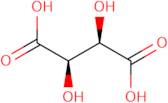
Informations sur le produit
- (+)-(2R,3R)-Tartaric acid
- (+)-(R,R)-Tartaric acid
- (+)-<span class="text-smallcaps">L</span>-Tartaric acid
- (+)-L-Tartaric acid
- (+)-Tartaric Acid
- (+)-Weinsaure
- (2R,3R)-2,3-Dihydroxybutanedioic acid
- (2R,3R)-2,3-Dihydroxysuccinic acid
- 1,2-Dihydroxyethane-1,2-dicarboxylic acid
- 2,3-Dihydroxybutanedioic acid
- Voir d'autres synonymes
- 2,3-Dihydroxysuccinic acid
- Acide (+)-tartrique
- Acido (+)-Tartarico
- Butanedioic Acid, 2,3-Dihydroxy-
- Butanedioic acid, 2,3-dihydroxy- [R-(R*,R*)]-
- Dextrotartaric acid
- Dihydroxy Butanedioic Acid
- Dihydroxysuccinic acid
- E 334
- Natural tartaric acid
- Nsc 62778
- Succinic acid, 2,3-dihydroxy
- Tartaric Acid AR (1LB/BT)
- Tartaric acid, <span class="text-smallcaps">L</span>-(+)-
- Tartaric acid, L-(+)-
- Threaric acid
- Weinsaeure
- d-Tartaric acid
- d-α,β-Dihydroxysuccinic acid
L-Tartaric acid is a white crystalline powder that is soluble in water. It is a model system for the study of calcium and its interactions with other ions, such as sodium and magnesium. L-Tartaric acid has been found to decrease the growth of carcinoma cell lines and increase the activity of certain enzymes, such as sodium salts, in mammalian cells. L-Tartaric acid crystals have been used for biological samples and electrochemical impedance spectroscopy. L-Tartaric acid also inhibits tumor growth in mice by inhibiting the production of proteins vital for cell division. This compound can be toxic at high doses and should not be administered to pregnant women or children.
Propriétés chimiques
Question d’ordre technique sur : 3D-FT04194 L-Tartaric acid
Si vous souhaitez demander un devis ou passer commande, veuillez plutôt ajouter les produits souhaités à votre panier, puis demander un devis ou passer commande à partir de votre panier. C'est une méthode plus rapide, plus économique, et vous pourrez bénéficier des remises disponibles ainsi que d'autres avantages





